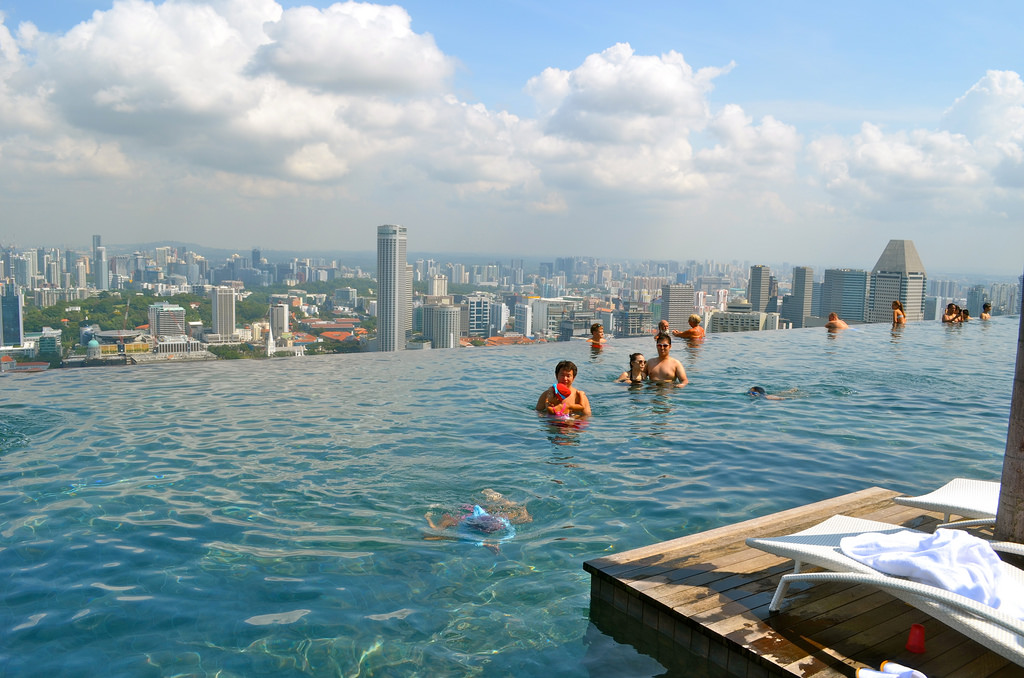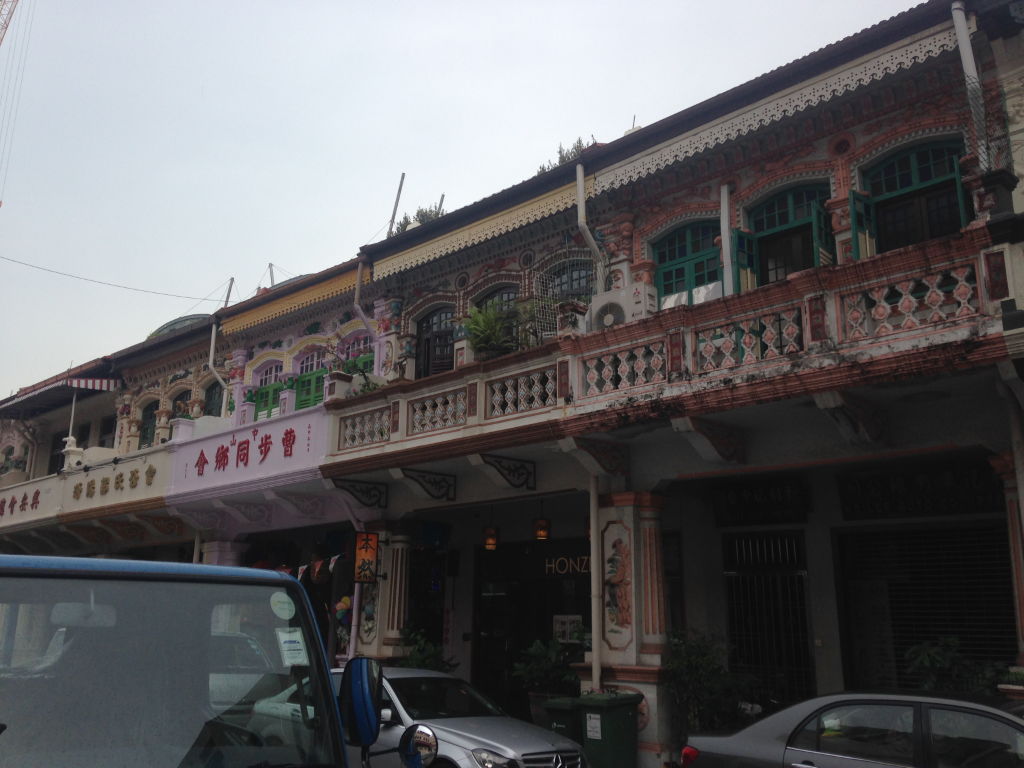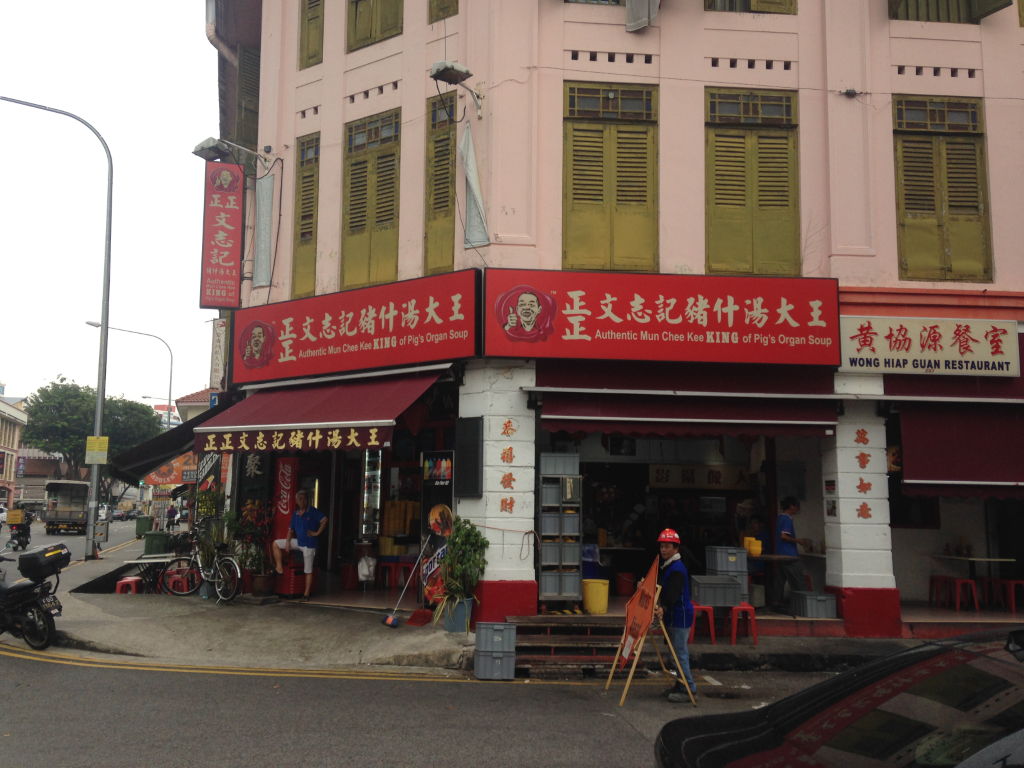I had been excited about this trip ever since I’d learned we would be going there. This is mainly due to my fascination with Raffles Hotel. It featured in Somerset Maugham’s short stories, a great favourite of mine, and also in the 80s drama series Tenko which told the story of a group of women who were taken prisoner in 1942 after getting caught up in the Japanese occupation after the fall of Singapore. As with the location of ‘The Beach’ in Thailand, I never thought I would have the chance to visit it. So, despite the lingering lethargy from jet lag and heat, I was eager to get going on Tuesday morning. Thwarted in our intention to travel the short distance across the water via an Uber taxi, we asked the driver to take us to the Malaysian immigration building where we could get a bus across the Second Link Bridge which traverses the Strait of Johor. The taxi driver was most apologetic that she couldn’t take us (she hadn’t brought her passport and Uber drivers don’t necessarily know the destination when they take the booking), but she told us the bus service is regular and efficient. Once inside the building we joined a queue, our passports were stamped and we walked outside to wait for the bus. After a journey of about 5 minutes, we had crossed the mile long bridge into Singapore and we all trooped off the bus straight into another building to queue for the Singapore immigration process. This took slightly longer, especially as we had to sidestep the queue while immigration forms were found for us to fill in. This slight delay meant we missed the first bus into Jurong where we needed to be to get a train to our hotel in Chinatown. It was raining heavily by then, so our first day in Singapore began somewhat unpromisingly in a cheerless, barn-like bus depot with several other people, wondering when the next bus would come along.
The first part of the journey to Jurong took us through through an industrial landscape of factories, trading estates and multi-storey office complexes. As we entered more rural areas, I noticed how well-maintained and wide the roads were. Further on, the views confirmed Singapore’s reputation as one of Southeast Asia’s wealthiest countries. The cars and motorbikes are mostly new and modern, while roadside shops, cafes, houses and even billboards all convey high standards of living and general affluence. The contrast to Thailand is staggering: there, the roads are bumpy and rock-strewn, cars and particularly motorbikes are often dangerously dilapidated. Singapore, at 580 square km is only slightly larger than the Isle of Wight but as the bus drew into Jurong and more and more skyscrapers appeared, it seemed incredible that we were in a small country. Its airport alone is a major hub for flights all over the world; one of the world’s busiest in fact. Looking around me at the huge town that isn’t even the capital I found it amazing to contemplate that the two islands are similar in size.

Navigating the MRT subway system proved to be gloriously simple. We bought cards that provided unlimited travel and boarded the train bound for Chinatown. Needless to say, the stations and trains are clean, spacious and efficient (chewing gum and eating on the subway carry sizeable fines). It was 1 pm by the time we got to our hotel but we couldn’t access our room until 2 so we left our bags there and went for a wander around the area. The black and white-themed Mono Hotel is in the middle of charming Mosque Street which has some beautiful colonial-style buildings.


Chinatown itself was a delightfully busy hub of noise, colour and appetising smells, much like Chinatowns globally tend to be I guess, but this one seemed to me to convey an additional upmarket, wealthy vibe in its streets. One street we passed had a plaque displaying information about its history. Boon Tat Street used to known as Japanese Street because it was the street where the Japanese brothels were located. It states that in the early 19th century, the prostitutes ‘plied their trade in an oddly noble effort to finance their country’s military campaigns’. Other streets used to be full of opium dens and illegal gambling venues. It was all happening there!


It got steadily hotter as we walked so we went for lunch in an air-conditioned mall which offered an abundance of food options. There were a lot more healthy choices here than I’ve seen in any other part of SE Asia. We opted for a place that was a bit like Subway but which used flavoured wraps instead of bread. After a bit of confusion and dithering on our part about how to choose from the options and deals, which the server handled with admirable patience and good humour, we ordered spinach wraps and chose from a delicious array of fillings (including a ‘protein’ section). Back at the hotel, soon after we checked in, I felt ready to flake out again so Paul went off to buy some of the items on his list from SIMLIM, a huge shopping complex solely devoted to selling technical parts and components, while I slept for a couple of hours.
Chinatown had really begun to liven up early in the evening when we went out again. People were filling its prettily-lit streets looking for places to eat, or browsing the stalls and street markets. We headed for the waterfront, a short walk from Chinatown where the Singapore River runs through the central area of the city and empties into the ocean at Marina Bay. The river was lined on both sides with plush bars and restaurants offering al fresco dining where the average price for a glass of wine was, we worked out, £8 a glass! We bought a small bottle of wine, some water and a coke for half of that price in a Seven Eleven and sat on a riverside wall – thus achieving the same effect for a whole lot cheaper ;).

We ambled around the bay area and bought vegetable samosas from one of the street vendors to munch on as we walked. There was a warm wind blowing across the river but it was the coolest we had felt all day. Singapore’s skyline is famous for three buildings with what I think looks like a plane but is in fact a ship lying across the top of them. We hadn’t seen it during the day but came upon the view of it by chance further along the riverside. It’s quite striking in the dark, the blinking lights on the ‘fuselage’ giving the appearance that it is still operating while stationary in its incongruous position.


The structure as a whole is The Marina Bay Sands Resort, completed in 2010, with a state of the art hotel, shopping malls and casinos – the ship on top is a 340 metre SkyPark complete with a 150 metre infinity pool! Would you fancy a swim in there?!

As the hotel didn’t include breakfast, we went out to find something nice after having coffee in the room. It was quite late by the time we hit the streets so when Paul led the way to a Chinese vegetarian place he’d found online, I was hungry enough to agree to the prospect of what was bound to be more substantial fare than cereal or toast. It turned out to be absolutely amazing! Everything in the bain-marie dishes on display was vegetarian and the helpful Chinese lady who served us explained what all of them were (although it has to be said we were none the wiser with some of the dishes). We were both game enough to try anything, though so we simply pointed and she heaped our plates. We took them to a table on the pavement outside and ate like the locals. It was unusual and delicious and vegan and it set us up for the rest of the day.

I needed that sustenance for the next venture. After a quick change in our room we headed for Little India on the metro to collect more of the things Paul needed for the boat. I got to see the SIMLIM complex that had impressed Paul the previous day. Keen to save my flagging energy for Raffles, I elected to stay in a café nursing a single glass of coke and reading while Paul browsed and shopped to his heart’s content. I think I even dozed off at one point I was so relaxed in there. I soon woke up when it was time to head to Raffles. It was only a short journey on the metro and a five minute walk from the station before the legendary beautiful building came into view. I still smile when I think of how pleasurable that sight was. Surrounded as it is by modern high rise apartments and hotels, Raffles shines both literally and metaphorically. The sunlight lit up the brilliant white façade and emphasised its immaculate, elegant appearance. The hotel doormen, dressed in Imperial Indian soldiers’ uniform, who were helping people out of a limousine as we approached completed the impression that this is still a place of opulence and luxury.

Visitors are welcome in the grounds and certain parts of the hotel but there is a dress code for specific areas. For afternoon tea it is smart casual – no shorts, bare shoulders or flip flops. We weren’t interested in that (especially at £36 a head), although I couldn’t resist a peek through the window at the three tier cake stands on tables loaded with dainty sandwiches, scones and fancy cakes and pastries. Refurbishment is taking place in some of the bars and restaurants so The Long Bar, where the famous Singapore Sling is usually served is closed and has moved to The Bar and Billiard Room, where there is thankfully no dress code. Before going there, though I had a browse in the souvenir shop while Paul sat in the courtyard to take a phone call.



There were enticing items in there (none of the usual ‘tat’ but the prices reflected that) and some intriguing books with information on the hotel’s development and history. I contented myself with some bookmarks and a small print of the building in colonial days. That it is expensive is not surprising – its reputation is built on its exclusivity: room rates here start at around £400 a night. I had wanted to see The Writers’ Bar but one of the doormen we asked explained that we couldn’t go in because it was open to residents’ only. Seeing my disappointment, however, the smartly dressed Indian doorman offered to escort me inside to show it to me (Paul couldn’t because he had shorts on). So I entered the palatial lobby and he led me over to the surprisingly small but stylish bar where writers, including Somerset Maugham, Joseph Conrad, Noel Coward and Rudyard Kipling used to drink, and it’s largely unchanged he told me. It was really kind of him, and it also gave me a chance to see the beautiful grand staircase in the lobby (I wasn’t allowed to take pictures inside unfortunately).

On we went to get a Singapore Sling – well it would have been a shame to miss out :). Immaculately dressed staff wait to escort people to a table where they are then presented with a menu listing the drinks and snacks on offer. The prices were eye-watering! I knew Paul wouldn’t have entered the place had it not been for me, and since even the soft drinks were extortionately expensive, we ordered just one Singapore Sling for the princely sum of 31 Ringgit (about £6). I just hoped they wouldn’t bring two straws! The bar reminded us of some that we’d been to in London and, it has to be said, some Wetherspoons’ pubs – except that guests were provided with complimentary sacks of peanuts in their shells and were invited to follow the custom of throwing the empty shells on the floor. The floor was littered with them and we added to it by consuming copious amounts of those nuts – they weren’t just any nuts after all, they were ‘Raffles’ nuts.


The drink was nice enough, a bit sweet for my taste and it may have been the sweetness which masked the alcohol but I’m not convinced there was much alcohol in it at all. The ingredients are listed on my souvenir bookmark, shown below, but I would have got more from my usual white wine and soda. Still, it was nice to sit there people watching for an hour.


On the way out, I paid the cashier 36 ringgit (the hike in price was for service apparently) while Paul took a few shots on the billiard table. The story goes that in 1902 a wild tiger had found its way into the hotel and was hiding underneath a billiard table in this very room. A local man was called upon to remove it and fired five shots under the table before finally hitting it between the eyes. It’s said that this was the last tiger to be shot in Singapore, but the hotel claims that the tiger was not wild – it had in fact escaped from a travelling circus. I couldn’t resist looking under the table and trying to imagine the scared tiger cowering under there :(.

Returning to Chinatown late in the afternoon, we collected our bags from the hotel, got the train to Bugis and walked to Queen Street near the border control to find a taxi rank. It was a huge relief that Paul was able to get a taxi to take us all the way back to Puteri. My legs and feet were really aching and we had heavier bags than we’d arrived with. All we had to do once we were sat in the back seat was hand our passports to the driver who presented them at the immigration and customs points along with his own. The immigration officer looked at us closely from his booth and held our passports up, said our names and we nodded. Paul was questioned about his immigration stamp, probably because it wasn’t from an airport like mine was, but we were waved through with no delays. The boat was like a furnace after being shut up all day when we got back on board in the evening but I had a feeling we wouldn’t be awake long enough for it to be too troublesome.
Some more images of Singapore below
Kathy






